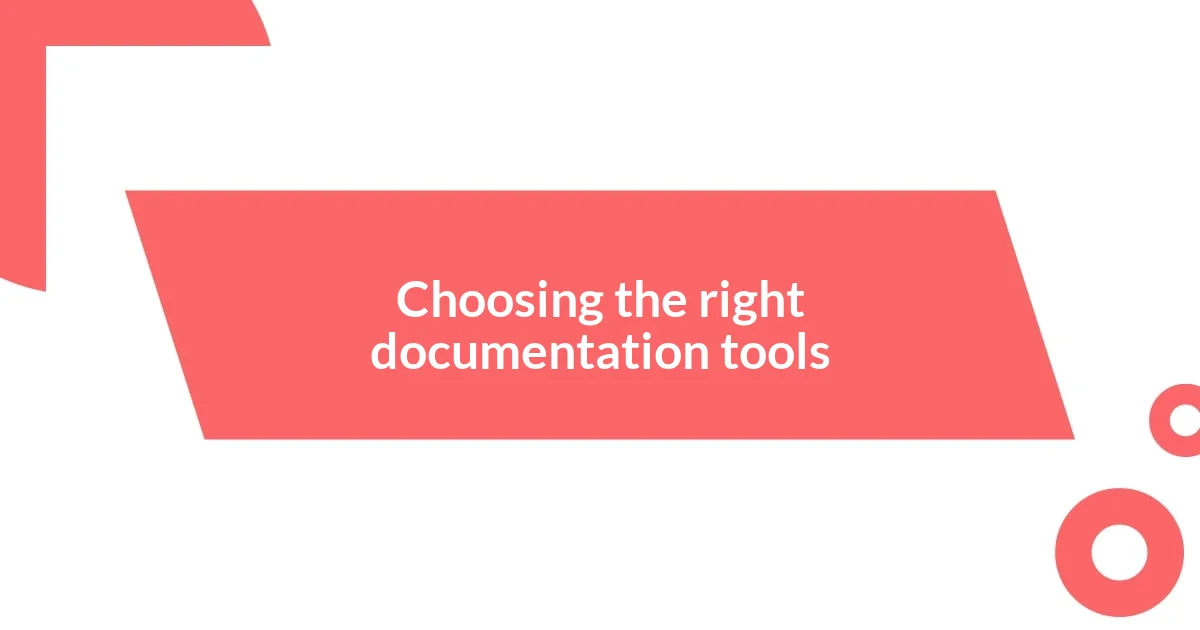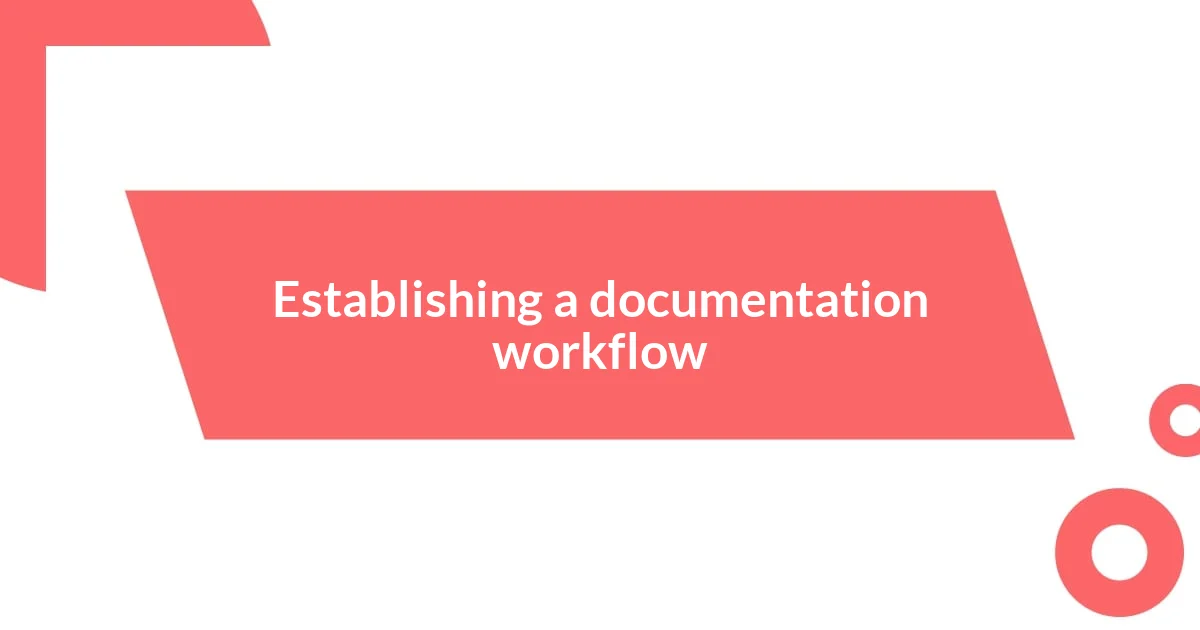Key takeaways:
- Importance of clear documentation to prevent costly mistakes and enhance workflow efficiency.
- Choosing user-friendly documentation tools and establishing a structured workflow fosters collaboration and accuracy.
- Regular reviewing and proactive sharing of documents promotes continuous improvement and innovative ideas.

Understanding the importance of documentation
Documentation might seem tedious, but think about those moments when you’ve frantically searched for a forgotten detail. In my experience, a well-organized document can be a lifesaver. It not only preserves knowledge but also fosters clarity and reduces mistakes. Have you ever missed a crucial step in a project? That’s often where solid documentation comes in—serving as a reliable reference point.
I remember a time when I overlooked important design specifications in a project because they weren’t documented correctly. The result? A significant amount of rework and an unnecessary stretch of deadlines. That experience really opened my eyes to how essential clear documentation is in avoiding costly errors and misunderstandings in any process.
Consider this: how much time would you save if every detail was accurately recorded and easily accessible? I’ve found that by investing time in documenting details upfront, I actually save time — and money — in the long run. It creates a smoother workflow and allows teams to collaborate more effectively, enhancing productivity and morale.

Choosing the right documentation tools
When it comes to selecting the right documentation tools, I firmly believe that usability should be at the forefront of your decision-making process. I’ve experimented with a variety of tools throughout my career, and I often found that the most intuitive ones significantly reduced the time I spent on documentation. If I’m struggling to figure out how to use a tool, it defeats the purpose of documentation itself—making the information easily accessible.
Here are some factors to consider:
– User Experience: Choose tools that are easy to navigate. A smooth user interface can make a world of difference.
– Collaboration Features: Look for tools that allow teamwork and communication. This is key for ensuring everyone is on the same page.
– Integration Capabilities: Consider how well the tool works with other software you use. Seamless integration saves time and frustration.
– Customizability: Find tools that allow you to tailor templates or workflows to your specific needs. Flexibility can enhance your documentation process.
– Cost-Effectiveness: Balance your budget with functionality. Sometimes free or low-cost options can be surprisingly powerful.
In my experience, I once chose a documentation tool that seemed great on paper, but had a steep learning curve that left my team frustrated. After struggling for weeks, we finally transitioned to a simpler, more user-friendly option. To my relief, it completely transformed our approach to documentation. It was such a satisfying moment to see my team not just using the tool but actually enjoying the process.

Establishing a documentation workflow
Establishing a documentation workflow requires careful planning and consistency. In my experience, creating a clear workflow helps avoid chaos later on. I’ve found that defining each step—from drafting to reviewing and finalizing—ensures that every detail is thoroughly documented. It reminds me of that time when I jumped into a project without a proper workflow. The confusion that ensued taught me that a structured approach not only saves time but also prevents stressful last-minute scrambles.
As I developed my documentation workflow, I became more aware of the role of feedback. Regularly seeking input from team members can enhance accuracy and clarity. Just last quarter, I set up a routine check-in process for documentation reviews, and it was a revelation. The team’s collective insights helped me refine my approach significantly. Sometimes, those small adjustments based on others’ perspectives make a massive impact on the end product, and having an open communication channel promotes accountability.
To streamline the workflow further, I also prioritize consistency in formatting and style. I always remind myself that uniformity enables quicker comprehension. When I first attempted a documentation project using various styles, it felt like I was piecing together a puzzle with missing pieces. I realized that a cohesive format not only makes the document visually appealing but also enhances its usability. This approach minimizes confusion and supports better retention of information for everyone involved.
| Step | Description |
|---|---|
| Drafting | Initial documentation of ideas and processes. |
| Reviewing | Gathering feedback to ensure accuracy and clarity. |
| Finalizing | Ensuring all details are in place before completion. |

Collecting and organizing information
Gathering information effectively starts with knowing where to look. I often reflect on times when I got lost in endless online searches, feeling overwhelmed by the sheer volume of data. A simpler approach that works for me is to break down my information needs into specific categories and then target my searches accordingly. It not only saves time but also provides a clear path to the relevant details I need.
Once I have collected the information, organization becomes the next crucial step. Personally, I use a combination of digital and physical tools that resonate with my way of thinking. For example, I often jot down ideas in a notebook during brainstorming sessions. Then, I transfer those thoughts into grouped digital folders according to themes or projects. This mix keeps my creative juices flowing while ensuring I can easily find what I need later. Have you ever experienced that satisfying moment when you effortlessly retrieve information you thought was lost? It reinforces the importance of organization in my process.
Finally, I can’t stress enough how essential it is to periodically review and refresh the organized information. In my earlier projects, I’d dump everything into folders and think, “Great, that’s done!” But I soon found myself sifting through outdated material. Now, I set reminders to revisit my organized files, ensuring that everything is relevant and up-to-date. This ongoing process not only maintains clarity but also boosts my confidence in the accuracy of the information I’m relying on. Isn’t it reassuring to know you’re working with the freshest data available?

Creating detailed and clear entries
Creating entries that are both detailed and clear is a skill I’ve honed over the years. I always start with the essentials: Who, What, When, Where, Why, and How. There was a time when I overlooked the ‘why’ in my notes, thinking it was unimportant. Looking back, I can see how that gap muddied the context for anyone reading my entries later. Including motivations and objectives not only clarifies my thoughts but also brings the content to life for others.
I’ve also learned to be mindful of my audience when crafting these entries. There’s a significant difference between writing for a technical team versus a general audience. A memorable experience was when I had to document a complex process for non-technical stakeholders. I found that using simpler language and relevant analogies made all the difference. How do you convey complex ideas in a way that resonates with everyone? I discovered that the right metaphors can bridge that gap tremendously.
Lastly, I advocate for the power of visuals to complement my written entries. When I started incorporating diagrams and charts into my documentation, I noticed a remarkable improvement in engagement and understanding. It reminds me of a project where a simple flowchart transformed a long-winded explanation into a digestible format. Have you ever tried to understand something complicated without visual aid? It’s often exhausting. Visuals not only clarify complex information but also keep the reader’s attention, making documentation more enjoyable to navigate.

Reviewing and updating documentation
Reviewing and updating documentation is an area where I’ve witnessed the transformative power of proactive engagement. Initially, I used to think of this process as a chore, something to do only when absolutely necessary. Then one day, I stumbled upon outdated documents during a meeting and felt that sinking feeling in my stomach. It struck me then how out-of-date information could undermine credibility. Now, I approach reviewing as an opportunity to enhance my work and stay aligned with the latest insights.
When I allocate time each month to revisit my documentation, I often find new details that spark fresh ideas. For instance, in one of my projects, I discovered that a slight update in a related field completely changed the context of my previous notes. It made me realize the importance of flexibility — my documents should evolve as knowledge does. Are you keeping an open mind when you review your work? This mindset allows me to enhance accuracy, relevance, and creativity within my documentation.
I also advocate for involving peers in this process, which has proven invaluable. A memorable experience was when a colleague offered a fresh perspective on a particularly dense document of mine. Their input turned into a beneficial brainstorming session that not only updated the document but also elevated the collaboration within our team. It serves as a reminder that two heads are indeed better than one. Have you ever considered how feedback could complement your review process? Engaging others not only breathes new life into documentation but also fosters a culture of continuous improvement.

Sharing and collaborating on documents
Sharing documents effectively is a game-changer in my experience. I remember the first big project where I sent out a draft for feedback, only to find that the response blew me away. The input I received not only refined my work but also created a sense of collaboration that was energizing. Have you ever felt that thrill when ideas bounce off each other? It’s that kind of synergy that makes sharing worthwhile.
When it comes to collaboration, I find that using tools like Google Docs can really enhance the process. I love being able to see real-time edits and comments from my team. There was a particular instance where a colleague suggested a different structure for a report while we were brainstorming together. That change not only improved clarity but also made the document more engaging. Have you realized how dynamic collaboration can dramatically uplift the quality of your work?
It’s essential to foster a culture of open communication around shared documents. From my own experience, I’ve observed that setting aside time for collaborative sessions can lead to unexpected breakthroughs. I recall one instance where a casual lunchtime meeting led to the revelation of a critical gap in our project plan. It made me realize that collaboration goes beyond just document sharing; it’s about building trust and openness. Isn’t it amazing how sharing insights can unlock deeper understanding and innovation?















